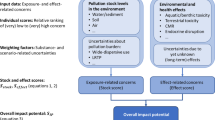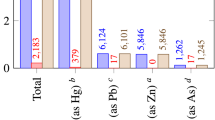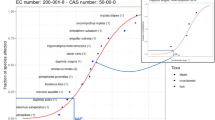Abstract
Goal, Scope and Background
The aim of this study has been to come up with recommendations on how to develop a selection method (SM) within the method development research of the OMNHTOX project. An SM is a method for prioritization of chemical emissions to be included in a Life Cycle Impact Assessment (LCIA) characterisation, in particular for (eco)toxicological impacts. It is therefore designed for pre-screening to support a characterisation method. The main reason why SMs are needed in the context of LCIA is the high number of chemical emissions that potentially contribute to the impacts on ecosystems and human health. It will often not be feasible to cover all emissions with characterisation factors and, therefore, there exists a need to focus the effort on the most significant chemical emissions in the characterisation step. Until now not all LCA studies include tox-icity-related impact categories, and when they do there are typically many gaps. This study covers the only existing methods explicitly designed as SMs (EDIP-selection, Priofactor and CPM-selection), the dominating Chemical Ranking and Scoring (CRS) method in Europe (EURAM) and in the USA (WMPT) that can be adapted for this purpose, as well as methods presenting novel approaches which could be valuable in the development of improved SMs (CART analysis and Hasse diagram technique).
Methods
The included methods are described. General guidance principles established for CRS systems are applied to SMs and a set of criteria for good performance of SMs is developed. The included methods are finally evaluated against these criteria.
Results and Discussion
Two of the most important performance criteria include providing consistent results relative to the more detailed, associated characterisation methods and the degree of data availability to ensure broader chemical coverage. Applicability to different chemical groups, user friendliness, and transparency are also listed amongst the important criteria. None of the evaluated methods currently fulfil all of the proposed criteria to a degree that excludes the need for development of improved selection methods.
Conclusion and Recommendations
For the development of SMs it is recommended that the general principles for CRS systems are taken into account. Furthermore, special attention should be paid to some specific issues, i.e. the emitted amount should be included, data availability should enable broad chemical coverage, and when identifying priority chemicals for the characterisation, the developed SM should generate few false positives (chemical emissions classified wrongly as being of high concern) and no (significant) false negatives (classified wrongly as being of low concern) as compared to the associated characterisation method. These recommendations are not only relevant for a stand alone SM, but also valuable when dealing with simple characterisation methods associated with a more detailed characterisation method.
Outlook
There are several questions that need to be answered before an optimal SM can be developed, inter alia: Is it optimal to just use simple measured data with high availability or are QSAR estimates of more complex, relevant data better? Which key parameters to include and how? Is a statistical approach, like linear regression of characterisation factors or CART analysis, the best solution?
Similar content being viewed by others
References
Bennett DH, McKone TE, Kastenberg W. (2001): CART Screening level analysis of persistence: A case study. In: Lipnick R L, Jansson B, Mackay D, Petreas M, (editors) (2001): Persistent, bio-accumulative and toxic chemicals II: Assessment and new chemicals. ACS symposium series 773. Published by American Chemical Society, Washington, DC. ISBN 0-8412-3675-5
Bennett DH, McKone TE, Kastenberg W, (2000): Evaluating multimedia persistence: Classification and regression tree analysis. Environ Toxicol Chem 19, 810–819
Brüggemann R, Bücherl C, Pudenz S, Steinberg CEW, (1999): Application of the concept of partial order on comparative evaluation of environmental chemicals. Acta hydroch hydrob 27 (3) 170–178
Brüggemann R, Halfon E, Welzl G, Voigt K, Steinberg CEW, (2001): Applying the concept of partial ordered sets on the ranking of near-shore sediments by a battery of tests. J Chem Inf Comp Sci 41 (4) 918–925
Bunke D, Gensch C-O, Moller M, Rüdenauer I, Ebinger F, Graulich K, (2003): Assessment of Toxicological Risk due to Hazardous Substances: Scoring of Risk Phrases. Int J LCA 8 (1) 6–7
Davis G, Fort D, Hansen BG, Irwin F, Jones B, Jones S, Socha A, Wilson R, Haaf B, Gray G, Hoffman B (1997): Framework for Chemical Ranking and Scoring Systems. Chapter 1 in: Chemical ranking and scoring: Guidelines for relative assessment of chemicals, Swanson M B and Socha A C (eds.), pp. 1-29. SETAC-US. Proceedings from the Pellston workshop on Chemical ranking and scoring, 12-16 February, 1995. Sandestin, Florida
de Koning A, Guinée J, Pennington DW, Sleeswijk A, Hauschild M, Molander S, Nyström B, Pant R, Schowanek D (2002): Methods and typology report Part A: Inventory and classification of LCA characterisation methods for assessing toxic releases. Contribution to Work-package 7 of the OMNIITOX Project as part A of appropriate deliverable D11
EC (1996): Environmental Risk Assessment. Technical Guidance Document in support of Commission Directive 93/67/EEC on Risk Assessment for New Notified Substances and Commission Regulation (EC) No. 1488/94 on Risk Assessment for Existing Substances (ed EC), pp 241-504. Office for Official Publications of the European Communities, Luxembourg
EC (2001): Adapting to technical progress for the 28th time Council Directive 67/548/EEC on the approximation of laws, regulation and administrative provisions relating to the classification, packaging and labelling of dangerous substances (Commission Directive 2001/59/EC, August 6)
EEC (1967): Approximation of laws, regulations and administrative provision relating to the classification, packaging and labelling of dangerous substances (Council Directive 1967/548/ EEC, June 27)
Eisenberg JN, McKone TE, (1998): Decision tree method for the classification of chemical pollutants: Incorporation of across-chemical variability and within-chemical uncertainty. Environ Sci Technol 32 (21) 3396–3404
Eriksson A, (1999): A comparative study of four models for eco-toxicological impact assessment in LCA—A case study of tyre emissions. Honour thesis in environmental science. Tutor Sverker Molander. June 1999. Güteborgs Universitet, Sweden
Fomsgaard I, Sørensen PB (1999): The Hasse diagram. In: Comparing Environmental Risk indicators for pesticides. Results of the CAPER project. Centre for Agriculture & Environment, The Netherlands. Report CLM 426-1999. ISBN 90-5634-106-5
Guinée JB, de Koning A, Pennington DW, Rosenbaum R, Hauschild M, Olsen SI, Molander S, Bachmann T M, Pant R, (2004): Bringing Science and Pragmatism together in a Tiered Approach for Modelling Toxicological Impacts in LCA. Int J LCA 9 (5) 320–326
Halfon E, Galassi S, Brüggemann R, Provini A, (1996): Selection of priority properties to assess environmental hazard of pesticides. Chemosphere 33 (8) 1543–1562
Hansen BG, Van Haelst AG, Van Leeuwen K, Van der Zandt P, (1999): Priority setting for existing chemicals: European Union risk ranking method. Environ Toxicol Chem 18, 772–779
IUCLID (2000): International Uniform Chemical Information Database. Public data on high volume chemicals, (existing chemicals). Year 2000 ed. European Chemicals Bureau. Ispra, Italy
Larsen HF, Birkved M, Hauschild M, Pennington D, Guinée JB (2002): Inventory of LCIA selection methods for assessing toxic releases. Methods and typology report part B. Contribution to Work-package 7 of the OMNIITOX Project as part B of appro- priate deliverable Dll. EC Project contract G1RD-CT-2001- 00501 http://www.omniitox.net
Larsen HF, Christensen FM, Rasmussen JO, Helweg C, Olsen SI (1999b): Screening tool for prioritization of chemicals to be included in a LCA study. Presented at the 9th Annual Meeting of SETAC-Europe, 25-29 May 1999 in Leipzig, Germany. Abstract No. 4c/001
Larsen HF, Christensen FM, Rasmussen JO, Helweg C, Olsen SI, (1999a): CETOX-LCA-Handbook, LCA on ‘chemical-heavy’ products. CETOX, Horsholm, Denmark
Lerche D, Sørensen PB, Larsen HS, Carlsen L, Nielsen O-J, (2002): Comparison of the Combined Monitoring-based and Modelling-based Priority Setting Scheme with Partial Order Theory and Random Linear Extension for Ranking of Chemical Substances. Chemosphere 49 (6) 637–649
Lerche D, Sørensen PB, Brüggemann R, (2003): Improved estimation of the ranking probabilities in partial orders using random linear extensions by approximation of the mutual ranking probability. J Chem Inf Comp Sci 43 (5) 1471–1480
Molander S, Lidholm P, Schowanek D, Recasens M, Fullana P, Christensen FM, Guinée JB, Hauschild M, Jolliet O, Carlson R, Pennington DW, Bachmann TM, (2004): OMNIITOX—Operational life-cycle impact assessment models and information tools for life-cycle impact assessment practitioners. Int J LCA 9 (5) 282–288
Olsen SI, Christensen FM, Hauschild M, Pedersen F, Larsen HF, Tørsløv J, (2001): Life cycle impact assessment and risk assessment—A methodological comparison. Environmental Impact Assessment Review 21, 385–404
Pedersen F, Tyle H, Niemelä JR, Guttmann B, Lander L, Wedebrand A (1995): Environmental Hazard Classification—Data collection and interpretation guide (2nd edition). TemaNord 1995:581. Nordic Council of Ministers
Pennington DW, Bare JC (2001). Comparison of chemical screening and ranking approaches: The Waste Minimization Prioritization Tool (WMPT) vs. Toxic Equivalency Potentials (TEPs). Risk Analysis 21 (5) 897- 913 Pennington DW, Bare JC, Knodell R, Carroll G, Martin T (2003): Evaluating Pollution Prevention Progress (P2P). Clean Technologies and Environmental Policy, in press
Sørensen PB, Mogensen BB, Gyldenkærne S, Rasmussen AG, (1998). Pesticide leaching assessment method for ranking both single substance and scenarios of multiple substance use. Chemosphere 36 (10) 2251–2276
US EPA (1997) Notice of availability of waste minimization software and documents. EPA530-C-97-003, Federal Register, 62:33868
US EPA (1998) Notice of availability of draft RCRA waste minimization PBT chemical list. 530-Z-98-009, Federal Register, 63:216
van de Meent D, Struijs J, Sijm D (2002): Simple recipe for calculating multi-substance toxic pressure as indicator of ecological impact of toxic substances. Presented at the 12th Annual Meeting of SETAC-Europe, 12-16 May 2002 in Vienna, Austria. Abstract No. 65-07
Wenzel H, Hauschild M, Alting L (1997): Environmental Assessment of Products, First edn. Chapman & Hall
Author information
Authors and Affiliations
Corresponding author
Rights and permissions
About this article
Cite this article
Larsen, H.F., Birkved, M., Hauschild, M. et al. Evaluation of selection methods for toxicological impacts in LCA recommendations for OMNIITOX. Int J LCA 9, 307–319 (2004). https://doi.org/10.1007/BF02979420
Received:
Accepted:
Issue Date:
DOI: https://doi.org/10.1007/BF02979420




